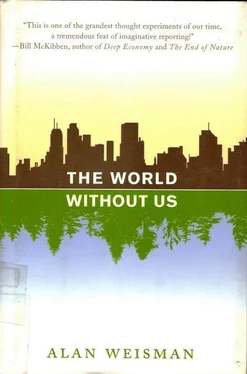As a result, especially in developing countries, millions of tons of CFCs are still used or linger in aging equipment, or are mothballed. If we vanish, millions of CFC and HCFC automobile air conditioners, and millions more domestic and commercial refrigerators, refrigerated trucks and railroad cars, as well as home and industry air-cooling units, will all finally crack and give up the chlorofluorocarbonated ghost of a 20th-century idea that went very awry.
All will rise to the stratosphere, and the convalescing ozone layer will suffer a relapse. Since it won’t happen all at once, with luck the illness will be chronic, not fatal. Otherwise, the plants and animals that remain in our wake will have to select for UV tolerance, or mutate their way through a barrage of electromagnetic radiation.
3. Tactical and Practical
Uranium-235, with a half-life of 704 million years, is a relatively insignificant fraction of natural uranium ore—barely .7 percent—but we humans have concentrated (“enriched”) several thousand tons of it for use in reactors and bombs. To do that, we extract it from uranium ore, usually by chemically converting it to a gas compound, then spinning it in a centrifuge to separate the different atomic weights. This leaves behind far less potent (“depleted”) U-238, whose half-life is 4.5 billion years: in the United States alone, there’s at least a half-million tons of it.
One approach to what to do with some of it involves the fact that U-238 is an unusually dense metal. In recent decades it has proved useful, when alloyed with steel, for fashioning bullets that can pierce armor, including the walls of tanks.
With so much surplus depleted uranium lying around, this is far cheaper for U.S. and European armies than buying the non-radioactive alternative, tungsten, which is mainly found in China. Depleted uranium projectiles range from 25-millimeter bullet size to three-foot-long, 120-millimeter darts with their own internal propellants and stabilizing fins. Their use kindles outrage over human health issues, on both the firing and receiving end. Because depleted uranium ordnance bursts into flames when it strikes, it leaves a pile of ash. Depleted or not, there’s enough concentrated U-238 in the bullet points that radioactivity in this debris can exceed 1,000 times the normal background level. After we’re gone, the next archaeologists to appear may unearth arsenals of several million of these super-dense, modern versions of Clovis spear points. Not only will they look considerably more fearsome, but—possibly unbeknownst to their discoverers—they’ll emit radiation for more years than the planet likely has left.
There are far hotter things than depleted uranium that will outlast us, whether we’re gone tomorrow or 250,000 years from now. It’s a big enough problem that we contemplate hollowing out entire mountains to store them. Thus far the United States has only one such site, in salt dome formations 2,000 feet below southeastern New Mexico, similar to the chemical-storage caverns below Houston. The Waste Isolation Pilot Plant, or WIPP, operating since 1999, is the boneyard for detritus from nuclear weapons and defense research. It can handle 6.2 million cubic feet of waste, the equivalent of about 156,000 55-gallon drums. In fact, much of the plutonium-drenched scrap it receives is packaged just that way.
WIPP isn’t designed to store spent fuel from nuclear generating plants, which in the United States alone increases by 3,000 tons each year. It is a landfill only for so-called low- and midlevel waste—stuff like discarded weapons-assembly gloves, shoe coverings, and rags soaked in contaminated cleaning solvents used in fashioning nuclear bombs. It also holds the dismantled remains of machines used to build them, and even walls from rooms where that happened. All this arrives on shrink-wrapped pallets containing hot hunks of pipe, aluminum conduits, rubber, plastic, cellulose, and miles of wiring. After its first five years, WIPP was already more than 20 percent full.
Its contents come from two dozen high-security warrens across the country, such as the Hanford Nuclear Reservation in Washington, where plutonium for the Nagasaki bomb was made, and Los Alamos, New Mexico, where it was assembled. In 2000, large wildfires hit both sites. Official reports say that unburied radioactive wastes were protected—but in a world without firefighters, they won’t be. Except for WIPP, all U.S. nuclear waste-storage containment is temporary. If it remains that way, fire will eventually breach it and send clouds of radioactive ash billowing across the continent, and possibly across the oceans.
The first site to begin shipping to WIPP was Rocky Flats, a defense facility on a foothills plateau 16 miles northwest of Denver. Until 1989, the United States made plutonium detonators for atomic weapons at Rocky Flats with somewhat less than a lawful regard for safety. For years, thousands of drums of cutting oil saturated with plutonium and uranium were stacked outside on bare ground. When someone finally noticed they were leaking, asphalt was poured over the evidence. Radioactive runoff at Rocky Flats frequently reached local streams; cement was swirled into radioactive sludge in absurd attempts to try to slow seepage from cracked evaporation ponds; and radiation periodically escaped into the air. A 1989 FBI raid finally closed the place. In the new millennium, after several billion dollars’ worth of intensive cleanup and public relations, Rocky Flats was transmuted into a National Wildlife Refuge.
Simultaneously, similar alchemy was recasting the old Rocky Mountain Arsenal next to Denver International Airport. RMA was a chemical-weapons plant that made mustard and nerve gas, incendiary bombs, napalm—and during peacetime, insecticides; its core was once called the most contaminated square mile on Earth. After dozens of wintering bald eagles were found in its security buffer, feasting on the prodigious prairie dog population, it, too, became a National Wildlife Refuge. That required draining and sealing an Arsenal lake where ducks once died moments after landing, and where the bottoms of aluminum boats sent to fetch their carcasses rotted within a month. Although the plan is to treat and monitor toxic groundwater plumes for another century until they’re considered safely diluted, today mule deer big as elk find asylum where humans once feared to tread.
A century, however, would make little difference to uranium and plutonium residues whose half-lives start at 24,000 years and keep going. The weapons-grade plutonium from Rocky Flats was shipped to South Carolina, whose governor was enjoined from lying in front of trucks to stop it. There, at the Savannah River Site’s Defense Waste Processing Facility, where two huge buildings (“reprocessing canyons”) are so contaminated that no one knows how they might be decommissioned, high-level nuclear waste is now melted in furnaces with glass beads. When poured into stainless steel containers, it turns into solid blocks of radioactive glass.
This process, called vitrification, is also used in Europe. Glass being one of our simplest, most durable creations, these hot glass bricks may be among the longest-lasting of all human creations. However, in places like England’s Windscale plant, scene of two nuclear accidents before it was finally closed, vitrified waste is stored in air-cooled facilities. One day, should power go off permanently, a chamber full of decaying, glass-embedded radioactive material would get steadily warmer, with shattering results.
The Rocky Flats asphalt where drums of radioactive oil spilled was also scraped and shipped to South Carolina, along with three feet of soil. More than half its 800 structures were razed, including the infamous “Infinity Room,” where contamination levels rose higher than instruments could measure. Several buildings were mostly underground; after the removal of items like the glove boxes used to handle the shiny plutonium disks that triggered A-bombs, the basement floors were buried.
Читать дальше











